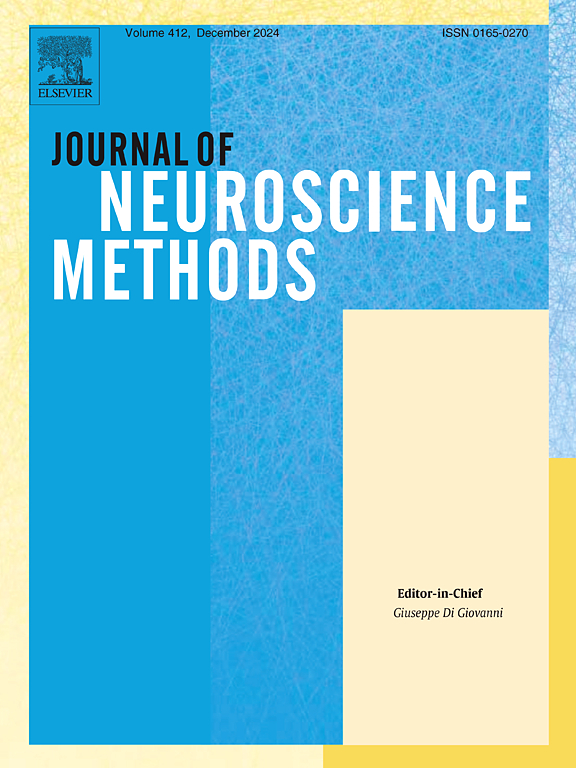Three-dimensional imaging and computational quantitation as a novel approach to assess nerve fibers, enteric glial cells, mast cells, and the proximity of mast cells to the nerve fibers in human sigmoid mucosal biopsies from healthy subjects
IF 2.7
4区 医学
Q2 BIOCHEMICAL RESEARCH METHODS
引用次数: 0
Abstract
Background
The visualization and quantitation of nerve fibers (NFs), enteric glial cells (EGCs), mast cells (MCs), and their spatial configurations in the human colonic mucosa represent considerable challenges due to the meshed network of these components and the arborizing of NFs in a three-dimensional (3D) structure.
New method
We developed a novel approach combining tissue clearing, 3D imaging and computerized quantitation of NFs, EGCs and MCs in sigmoid mucosal biopsies of healthy subjects using a modified CLARITY tissue clearing protocol and adapting Imaris Surfaces Rendering Technology.
Results
The cleared colonic biopsies are compatible with immunostaining using 10 marker antibodies and capable of generating 3D images rendering clear spatial views and computational quantitation of NFs, MCs, EGCs, in particular the proximity of MCs to NFs with Imaris 9.7–9.9.
Comparison with existing methods
Our modified tissue clearing protocol shortened the membrane lipid removal time to 1 day from the original 1–2 weeks and total tissue clearing time to 3–4 days from the original 2–4 weeks. The 3D images displayed a clear spatial landscape of NFs, MCs and EGCs in the biopsies which cannot be portrayed with 2D images acquired from sections. Computerized quantitation is faster than measuring manually, allowing us to quantify a larger number of samples with less bias.
Conclusion
The novel approach enables faster tissue clearing/immunolabeling, high-quality 3D imaging and precise computational quantitation of NFs, cells and proximity of MCs to NFs in human sigmoid biopsies which may allow new insight to detect alterations in colonic-related diseases.
三维成像和计算定量作为评估健康人体乙状结肠粘膜活检中神经纤维、肠胶质细胞、肥大细胞和肥大细胞与神经纤维接近程度的新方法
神经纤维(NFs)、肠胶质细胞(EGCs)、肥大细胞(MCs)及其在人类结肠粘膜中的空间结构的可视化和定量研究面临着相当大的挑战,因为这些成分的网状网络和NFs在三维(3D)结构中的树形化。我们开发了一种结合组织清除、3D成像和计算机定量健康受试者乙状窦粘膜活检的NFs、EGCs和MCs的新方法,使用改进的CLARITY组织清除协议和适应Imaris表面渲染技术。结果清除后的结肠活检与使用10种标记抗体的免疫染色相兼容,能够生成三维图像,绘制清晰的空间视图和计算定量的NFs, MCs, EGCs,特别是MCs与NFs的接近度,Imaris 9.7-9.9。与现有方法比较,sour修饰的组织清除方案将膜脂去除时间从原来的1 - 2周缩短为1 天,总组织清除时间从原来的2-4周缩短为3-4天。三维图像显示了活检组织中NFs, MCs和EGCs的清晰空间景观,这是通过切片获得的二维图像无法描绘的。计算机量化比人工测量更快,使我们能够以更少的偏差量化更多的样本。结论该新方法能够在人乙状结肠活检中实现更快的组织清除/免疫标记、高质量的3D成像和精确的NFs、细胞和MCs与NFs接近度的计算定量,这可能为检测结肠相关疾病的改变提供新的见解。
本文章由计算机程序翻译,如有差异,请以英文原文为准。
求助全文
约1分钟内获得全文
求助全文
来源期刊

Journal of Neuroscience Methods
医学-神经科学
CiteScore
7.10
自引率
3.30%
发文量
226
审稿时长
52 days
期刊介绍:
The Journal of Neuroscience Methods publishes papers that describe new methods that are specifically for neuroscience research conducted in invertebrates, vertebrates or in man. Major methodological improvements or important refinements of established neuroscience methods are also considered for publication. The Journal''s Scope includes all aspects of contemporary neuroscience research, including anatomical, behavioural, biochemical, cellular, computational, molecular, invasive and non-invasive imaging, optogenetic, and physiological research investigations.
 求助内容:
求助内容: 应助结果提醒方式:
应助结果提醒方式:


